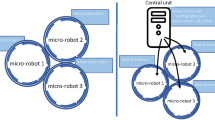Abstract
A modular robot can be built with a shape and function that matches the working environment. We developed a four-arm modular robot system which can be configured in a planar structure. A learning mechanism is incorporated in each module constituting the robot. We aim to control the overall shape of the robot by an accumulation of the autonomous actions resulting from the individual learning functions. Considering that the overall shape of a modular robot depends on the learning conditions in each module, this control method can be treated as a dispersion control learning method. The learning object is cooperative motion between adjacent modules. The learning process proceeds based on Q-learning by trial and error. We confirmed the effectiveness of the proposed technique by computer simulation.
Similar content being viewed by others
Explore related subjects
Discover the latest articles, news and stories from top researchers in related subjects.References
Fukuda T, Nakagawa S (1988) Dynamically reconfigurable robotics system. Proceedings of the IEEE International Conference on Robotics and Automation, IEEE Computer Society Press, pp 1581–1586
Chirikjian GS (1993) Metamorphic hyper-redundant manipulators. Proceedings of the JSME International Conference on Advanced Mecatronics, The Japan Society of Mechanical Engineers, pp 467–472
Yim M (1994) New locomotion gaits. Proceedings of the IEEE ICRA, IEEE Computer Society Press, pp 2508–2514
Paredis C, Brown HB, Khosla P (1996) A rapidly deployable manipulator system. Proceedings of the IEEE ICRA, IEEE Computer Society Press, pp 1434–1439
Pamecha A, Ebert-Uphoff I, Chirikjian G (1997) Useful metric for modular robot motion planning. IEEE Trans Robotics Autom 13:531–545
Rus D, Vona M (2001) Crystalline robots: self-reconfiguration with compressible unit modules. Auton Robots 10:107–124
Chiang C-H, Chirikjian G (2001) Modular robot motion planning using similarity metrics. Auton Robots 10:91–106
Shen W-M, Salemi B, Will P (2002) Hormone-inspired adaptive communication and distributed control for CONRO. IEEE Trans Robotics Autom 18(5):700–712
Walter J, Welch J, Amato N (2000) Distributed reconfiguration of metamorphic robot chains. Proceedings of the 19th Annual ACM SIGACT-SIGOPS Symposium on Principles of Distributed Computing (PODC 2000), Portland, pp 171–180
Bulter Z, Kotay K, Rus D, et al (2001) Cellular automata for decentralized control of self-reconfigurable robots. Proceedings of the 2001 IEEE International Conference on Robotics and Automation, Workshop on Robotics: Modular Robots, IEEE Computer Society Press
Watkins CJCH, Dayan P (1992) Q-learning. Machine Learning 8:279–292
Sutton RS, Barti AG (1998) Reinforcement learning: an introduction. MIT Press, Cambridge
Kotay K, Rus D (1999) Locomotion versatility through self-reconfiguration. Robotics Auton Syst 26:217–232
Rus D, Vona M (2001) Crystalline robots: self-reconfiguration with unit-compressible modules. Auton Robots 10:107–124
Ito K (2000) Intelligence and emergence. NTT Publishing, Japan, pp 60–70
Author information
Authors and Affiliations
Corresponding author
Additional information
This work was presented in part at the 14th International Symposium on Artificial Life and Robotics, Oita, Japan, February 5–7, 2009
About this article
Cite this article
Shiba, S., Uchida, M., Nozawa, A. et al. Autonomous reconfiguration of robot shape by using Q-learning. Artif Life Robotics 14, 213–218 (2009). https://doi.org/10.1007/s10015-009-0656-3
Received:
Accepted:
Published:
Issue Date:
DOI: https://doi.org/10.1007/s10015-009-0656-3




